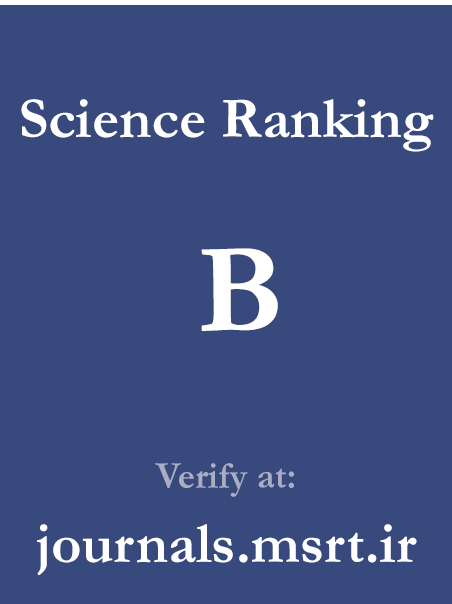Relationship Between Math Anxiety and Problem-Solving in Dyscalculic Children: Mediating Role of Working Memory
Keywords:
Developmental dyscalculia, Math anxiety, Working memory, Problem-solvingAbstract
Purpose: The present study aimed to examine the relationship between math anxiety and problem-solving ability in children with developmental dyscalculia, with a specific focus on the mediating role of working memory.
Methods and Materials: This research employed a descriptive correlational design. A sample of 400 students diagnosed with dyscalculia was selected from elementary schools in Tehran using stratified random sampling, based on the Morgan and Krejcie table. Data were collected using three validated instruments: the Mathematics Anxiety Rating Scale for Elementary Students (MARS-E), the Working Memory Rating Scale (WMRS), and the Problem-Solving Inventory for Children. Data analysis was conducted using SPSS-27 for descriptive statistics and Pearson correlation analysis, while Structural Equation Modeling (SEM) was performed using AMOS-21 to test the hypothesized mediational model.
Findings: Results revealed that math anxiety was negatively correlated with both working memory (r = –.46, p < .001) and problem-solving ability (r = –.39, p < .001), while working memory had a significant positive correlation with problem-solving (r = .51, p < .001). SEM results indicated a good model fit (χ²/df = 2.06; CFI = 0.96; RMSEA = 0.051). Math anxiety significantly predicted working memory (β = –.46, p < .001), and working memory significantly predicted problem-solving ability (β = .51, p < .001). The direct path from math anxiety to problem-solving was weak but significant (β = –.09, p = .031), while the indirect effect through working memory was stronger (β = –.23, p < .001), confirming partial mediation.
Conclusion: The findings demonstrate that working memory plays a significant mediating role in the relationship between math anxiety and problem-solving in dyscalculic children. Educational interventions aimed at enhancing working memory and reducing math anxiety may be effective in improving problem-solving skills in this population.
Downloads
References
Al-Shamy, H. (2020). Relation of Creative Problem Solving With Efficient Working Memory in A Sample of Gifted Students at King Faisal University in Saudi Arabia. Humanities and Management Sciences - Scientific Journal of King Faisal University, 21(1). https://doi.org/10.37575/h/edu/2048
Alfonso, S. V., & Lonigan, C. J. (2021). Trait anxiety and adolescent's academic achievement: The role of executive function. Learning and Individual Differences, 85, 101941. https://doi.org/10.1016/j.lindif.2020.101941
Asadi Rajani, M. (2023). Investigating the Performance of Selective Attention and Working Memory in Adolescents Recovered from Acute Covid-19 with Normal Adolescents. International Journal of Education and Cognitive Sciences, 3(4), 44-51. https://doi.org/10.22034/injoeas.2023.357896.1036
Baniasadi, T. (2024). Comparison of Executive Function and Working Memory among Children with High and Low Levels of Physical Activity. International Journal of Education and Cognitive Sciences, 5(3), 9-15. https://doi.org/10.61838/kman.ijeas.5.3.2
Devine, A., Hill, F., Carey, E., & Szűcs, D. (2018). Cognitive and Emotional Math Problems Largely Dissociate: Prevalence of Developmental Dyscalculia and Mathematics Anxiety. Journal of Educational Psychology, 110(3), 431-444. https://doi.org/10.1037/edu0000222
Ellis, D. M., Ball, B. H., Kimpton, N., & Brewer, G. A. (2020). The Role of Working Memory Capacity in Analytic and Multiply-Constrained Problem-Solving in Demanding Situations. Quarterly Journal of Experimental Psychology, 73(6), 920-928. https://doi.org/10.1177/1747021820909703
Galitskaya, V., & Drigas, A. (2021). The Importance of Working Memory in Children With Dyscalculia and Ageometria. Scientific Electronic Archives, 14(10). https://doi.org/10.36560/141020211449
Mammarella, I. C., Toffalini, E., Caviola, S., Colling, L., & Szűcs, D. (2021). No evidence for a core deficit in developmental dyscalculia or mathematical learning disabilities. Journal of Child Psychology and Psychiatry, 62(6), 704-714. https://doi.org/10.1111/jcpp.13397
McCaskey, U., Von Aster, M., O'Gorman Tuura, R., & Kucian, K. (2017). Adolescents with developmental dyscalculia do not have a generalized magnitude deficit - processing of discrete and continuous magnitudes. Frontiers in human neuroscience, 11, 102. https://doi.org/10.3389/fnhum.2017.00102
Rajabi, S., Abolghasemi, A., & Abbasi, M. (2012). The role of self-esteem and test anxiety in predicting life satisfaction in students with dyscalculia. Journal of Learning Disabilities, 1(3), 46. https://www.magiran.com/paper/1008593
Schäfer, J., Reuter, T., Leuchter, M., & Karbach, J. (2024). Executive functions and problem-solving: The contribution of inhibition, working memory, and cognitive flexibility to science problem-solving performance in elementary school students. Journal of Experimental Child Psychology, 244, 105962. https://doi.org/10.1016/j.jecp.2024.105962
Scheibe, D. A., Was, C. A., Dunlosky, J., & Thompson, C. A. (2023). Metacognitive Cues, Working Memory, and Math Anxiety: The Regulated Attention in Mathematical Problem Solving (RAMPS) Framework. Journal of Intelligence, 11(6), 117. https://doi.org/10.3390/jintelligence11060117
Utami, N. W., & Warniasih, K. (2019). Working Memory on Mathematical Problem Solving Activity: Case Study in Low Ability Students. Journal of Physics Conference Series, 1254(1), 012070. https://doi.org/10.1088/1742-6596/1254/1/012070
Vasheghani Farahani, A., & Rostaminejād, M. (2021). The Effect of Cognitively Guided Instruction on students’ Self-direction rate in Learning and Math Anxiety. Journal of Educational Innovations, 20(1), 151-184. https://doi.org/10.22034/jei.2021.128605
Wilkey, E. D., Pollack, C., & Price, G. R. (2020). Dyscalculia and typical math achievement are associated with individual differences in number‐specific executive function. Child development, 91(2), 596-619. https://doi.org/10.1111/cdev.13194
Witzel, B., & Mize, M. (2018). Meeting the Needs of Students with Dyslexia and Dyscalculia. SRATE journal, 27(1), 31-39. https://eric.ed.gov/?id=EJ1166703
Xing, Q., Lu, Z., & Hu, J. (2019). The Effect of Working Memory Updating Ability on Spatial Insight Problem Solving: Evidence From Behavior and Eye Movement Studies. Frontiers in psychology, 10. https://doi.org/10.3389/fpsyg.2019.00927
Zafar, U. e. H., Arshad, F., Karamat, A., Hayat, U., Khan, Z. K., & Ashraf, T. (2025). The Role of Working Memory in Problem-Solving and Decision-Making. Bbe, 14(2), 11-16. https://doi.org/10.61506/01.00586
Downloads
Published
Submitted
Revised
Accepted
Issue
Section
License
Copyright (c) 2025 Maryam Gilasiyan (Corresponding author)

This work is licensed under a Creative Commons Attribution-NonCommercial 4.0 International License.

